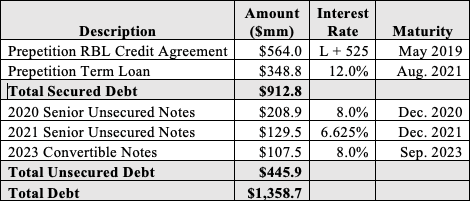🏠New Chapter 11 Bankruptcy Filing - Stearns Holdings LLC🏠
Stearns Holdings LLC
July 9, 2019
Hallelujah! Something is going on out in the world aside from the #retailapocalypse and distressed oil and gas. Here, Blackstone Capital Partners-owned Stearns Holdings LLC and six affiliated debtors (the “debtors”) have filed for bankruptcy in the Southern District of New York because of…drumroll please…rising interest rates. That’s right: the FED has claimed a victim. Stephen Moore and Judy Shelton must be smirking their faces off.
The debtors are a private mortgage company in the business of originating residential mortgages; it is the 20th largest mortgage lender in the US, operating in 50 states. We’ll delve more deeply into the business model down below but, for now, suffice it to say that the debtors generate revenue by producing mortgages and then selling them to government-sponsored enterprises such as Ginnie Mae, Fannie Mae and Freddie Mac. There are a ton of steps that have to happen between origination and sale and, suffice it further to say, that requires a f*ck ton of debt to get done. That said, on a basic level, to originate loans, the debtors require favorable interest rates which, in turn, lower the cost of residential home purchases, and increases market demand and sales activity for homes.
Except, there’s been an itsy bitsy teeny weeny problem. Interest rates have been going up. Per the debtors:
The mortgage origination business is significantly impacted by interest rate trends. In mid-2016, the 10-year Treasury was 1.60%. Following the U.S. presidential election, it rose to a range of 2.30% to 2.45% and maintained that range throughout 2017. The 10-year Treasury rate increased to over 3.0% for most of 2018. The rise in rates during this time period reduced the overall size of the mortgage market, increasing competition and significantly reducing market revenues.
Said another way: mortgage rates are pegged off the 10-year treasury rate and rising rates chilled the housing market. With buyers running for the hills, originators can’t pump supply. Hence, diminished revenues. And diminished revenues are particularly problematic when you have high-interest debt with an impending maturity.
This is where the business model really comes into play. Here’s a diagram illustrating how this all works:
Source: First Day Declaration, PETITION
The warehouse lenders got nervous when, over the course of 2017/18, mortgage volumes declined while, at the same time, the debtors were obligated to pay down the senior secured notes; they, rightfully, grew concerned that the debtors wouldn’t have the liquidity available to repurchase the originated mortgages within the 30 day window. Consequently, the debtors engaged PIMCO in discussions about the pending maturity of the notes. Over a period of several months, however, those discussions proved unproductive.
The warehouse lenders grew skittish. Per the debtors:
Warehouse lenders began reducing advance rates, increasing required collateral accounts and increasing liquidity covenants, further contracting available working capital necessary to operate the business. Eventually, two of the warehouse lenders advised the Debtors that they were prepared to wind down their respective warehouse facilities unless the Debtors and PIMCO agreed in principle to a deleveraging transaction by June 7, 2019. That did not happen. As a result, one warehouse lender terminated its facility effective June 28, 2019 and a second advised that it will no longer allow new advances effective July 15, 2019. The Debtors feared that these actions would trigger other warehouse lenders to take similar actions, significantly impacting the Debtors’ ability to fund loans and restricting liquidity, thereby jeopardizing the Debtors’ ability to operate their franchise as a going concern.
On the precipice of disaster, the debtors offered the keys to PIMCO in exchange for forgiveness of the debt. PIMCO rebuffed them. Subsequently, Blackstone made PIMCO a cents-on-the-dollar cash-out offer on the basis that the offer would exceed liquidation value of the enterprise and PIMCO again declined. At this point there’s a lot of he said, she said about what was offered and reneged upon to the point that it ought to suffice merely to say that the debtors, Blackstone and PIMCO probably aren’t all sharing a Hamptons house together this summer.
So, where did they end up?
The debtors have filed a plan of reorganization with Blackstone as plan sponsor. Blackstone agreed to inject $60mm of new equity into the business — all of which, notably, is earmarked to cash out the notes in their entirety (clearly at at discount — read: below par — for PIMCO and the other noteholders). The debtors also propose to subject Blackstone’s offer to a 30-day competitive bidding process, provided that (a) bids are in cash (credit bids will not be allowed) and (b) all obligations to the GSEs and other investors are honored.
To fund the cases the debtors have obtained a commitment from Blackstone for $35mm in DIP financing. They also sourced proposals from warehouse lenders prepetition and have obtained commitments for $1.5b in warehouse financing from Barclays Bank PLC and Nomura Corporate Funding Americas LLC (guaranteed, on a limited basis, by Blackstone). In other words, Blackstone is ALL IN here: with the DIP financing, the limited guarantee and the equity check, they are placing a stake in the ground when it comes to mortgage origination.
Jurisdiction: S.D. of New York (Judge Chapman)
Capital Structure: $184mm 9.375% ‘20 senior secured notes (Wilmington Trust Association NA)
Professionals:
Legal: Skadden Arps Slate Meagher & Flom LLP (Jay Goffman, Mark McDermott, Shana Elberg, Evan Hill, Edward Mahaney-Walter)
Financial Advisor: Alvarez & Marsal LLC (Robert Campagna)
Investment Banker: PJT Partners LP (Jamie O’Connell)
Claims Agent: Prime Clerk LLC (*click on the link above for free docket access)
Board of Directors: David Schneider, William Cary, Glenn Stearns, Nadim El Gabbani, Chinh Chu, Jason Roswig, Chris Mitchell
Other Parties in Interest:
Indenture Trustee: Wilmington Trust Association NA
Legal: Alston & Bird LLP (Jason Solomon)
Major Noteholder: Pacific Investment Management Company LLC
Legal: Hogan Lovells US LLP (Bennett Spiegel, Stacey Rosenberg)
Blackstone Capital Partners VI-NQ/NF LP
Legal: Simpson Thacher & Bartlett LLP (Elisha Graff, Jamie Fell)
Barclays Bank PC
Legal: Hunton Andrews Kurth LLP (Peter Partee Sr., Brian Clarke)
Nomura Corporate Funding Americas LLC
Legal: Milbank LLP (Mark Shinderman, Lauren Doyle) & Alston & Bird LLP (Karen Gelernt)
Fannie Mae
Legal: O’Melveny & Myers LLP (Stephen Warren)
Freddie Mac
Legal: McKool Smith PC (Paul Moak)
7/9/19 #30

























